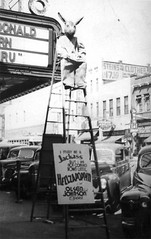
A “Jackass” sits atop a tall ladder in front of the Palmetto Theater to promote “Hellzapoppin” starring the comedy team of Olsen and Johnson. The sign on the ladder reads, “I may be a Jackass but I’m not coming down until Helzapoppin’ with Olsen and Johnson opens.” The film was released in 1941 by Universal Pictures. Via here
[Youtube=http://www.youtube.com/watch?v=Bmw7un31UR0&]
A Cadillac commercial by Dylan centered around Bob’s radio show
Spent yesterday evening in the vicinity of the Nachtegalenpark where I listened to The Faces, Nicola Conte‘s newest compilation but most of all to Bob Dylan‘s The Best of Bob Dylan’s Theme Time Radio Hour. Came home and got sick. Slept for more than 15 hours.
Woke up and thought about Black Surrealism, through my first exposure to the work of Slim Gaillard and his role in films such as the 1941 film Hellzapoppin’, of which Ado Kyrou was a fan. Black Surrealism is a concept first put forward by Robin D.G. Kelley in A Poetics of Anticolonialism (1999), although he had overlooked the popular dimension of the concept.
The popular strains of any art form are often forgotten, take for example Ma and Pa Kettle, the American comic duo known for their celebration of the absurd, but much less known and appreciated than comparable films by Jacques Tati (I am referring specifically to Tati’s attack on modernity which was just as prevalent in the Kettle films).
To conclude, a recommendation: if you only buy one CD in 2008, make it Bob Dylan‘s The Best of Bob Dylan’s Theme Time Radio Hour. You’ll enjoy tracks such as Mary Gauthier’s “I Drink”, Dinah Washington’s bawdy “Long Big Sliding Thing” and many more. Trust me.










